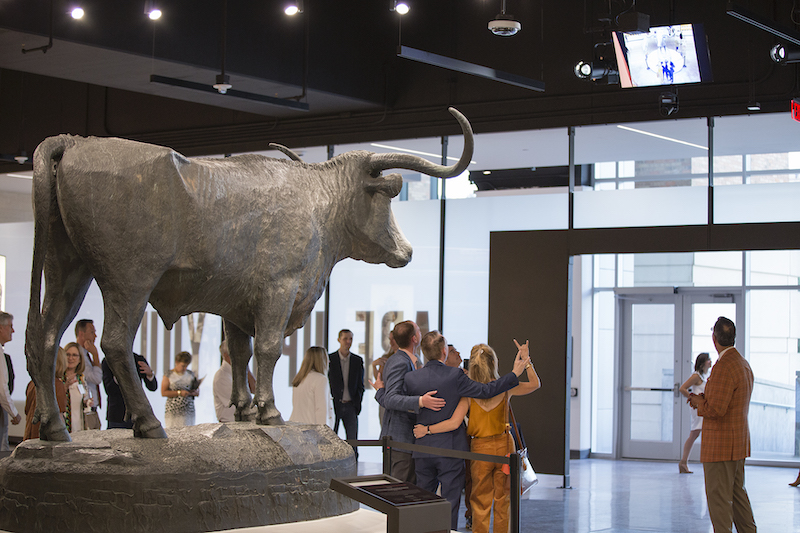Last Friday, the University of Texas at Austin held a grand opening ceremony for the Frank Denius Family Athletics Hall of Fame, a 24,713-sf space that is located at the north endzone of Darrell K. Royal-Texas Memorial Stadium.
The $17.1 million space, designed by Page and built by Turner Construction, includes 392 trophies earned over the decades by the university’s 20 sports teams. Visual and digital displays celebrate UT’s 55 national championship teams, 599 conference team titles, 144 individual national champions, and 171 Olympians who have won 145 medals.
The national champions are highlighted in their own 1,400-sf room with a 16x9-ft monitor that plays videos commemorating team title victories.
Also included in the Hall of Fame is an 8-ft-tall, 1,200-lb statue honoring the school’s mascot, the longhorn Bevo. The Hall of Fame offers a visual timeline of the 15 Bevos in Texas’ history since 1917.
Nashville, Tenn.-based Advent was a co-collaborator on this project, responsible for creating the “stories” that identify special touchstones and moments in the history of UT’s athletic programs.
John Roberson, Advent’s owner, had worked previously with Chris Del Conte, UT’s Athletic Director, when Del Conte held the same post at Texas Christian University. “Chris was brought in as a change agent, to restore the culture” for UT’s athletic program, Roberson tells BD+C.
That culture, he explains, is defined by stories “that are repeated.” Telling those stories required Advent to pull together the school’s trophies and other memorabilia that were scattered all over the place. For example, a Wheaties box that featured UT’s 2005 national championship football team and its legendary coach Mack Brown was found in someone’s garage. Trophies won by the school’s baseball team were located in crates in the basement of the team’s fieldhouse.
It’s not just the trophies that matter, though, says Roberson. “It’s identifying the heroes” and the narratives about individuals, teams, and special moments. Advent helped UT select those people and events using a proprietary process called “story mining,” which Roberson describes as “empathetic listening” to stakeholders. Advent used data analysis software to identify within those captured stories what needed to be told “to uncover the emotions” of the time and place.
“We’re transporting you, taking you back,” says Roberson, via images and interactive exhibits. “Memory is created by the experience that causes wonderment.”

A statue of UT's mascot, the longhorn Bevo, is prominently displayed in the Hall of Fame. Image: Rick Myers/Advent
Darrell K. Royal-Texas Memorial is the ninth-largest stadium in the world, with a seating capacity of 100,119. So, says Roberson, several hundred thousand people could conceivably visit the Hall of Fame during the football team’s season, which opened with a 45-14 win over Louisiana Tech University last Saturday. Roberson expects UT to also use this facility as part of its student recruitment effort, and to lease it out for events like weddings.
He believes the Hall of Fame is a “smart investment” for the university to recapture a space that had been a wide concourse and circulation area with a modest food court.
In conjunction with the opening of the Hall of Fame, UT has entered into a joint branding agreement with the U.S. Olympic and Paralympic Committee in an effort to strengthen Olympic sports programming at the collegiate level. The tagline for the campaign is “Olympians Made Here.”
The Athletics Hall of Fame is named after Frank Denius, an alumnus who passed away in 2018 at the age of 93. Denius was a decorated World War II veteran, having been awarded four Silver Stars and two Purple Hearts. He earned two degrees, in business and law, at UT, and supported the university philanthropically.
Related Stories
Sports and Recreational Facilities | Jul 7, 2021
Chicago’s first indoor track and field facility features a hydraulically banked track
It is the first hydraulically banked track in Illinois.
Resiliency | Jun 24, 2021
Oceanographer John Englander talks resiliency and buildings [new on HorizonTV]
New on HorizonTV, oceanographer John Englander discusses his latest book, which warns that, regardless of resilience efforts, sea levels will rise by meters in the coming decades. Adaptation, he says, is the key to future building design and construction.
Sports and Recreational Facilities | Jun 16, 2021
Populous designs 9,000-seat stadium and training center for the Brisbane Lions
The project will include fields for public use.
Digital Twin | May 24, 2021
Digital twin’s value propositions for the built environment, explained
Ernst & Young’s white paper makes its cases for the technology’s myriad benefits.
Sports and Recreational Facilities | May 17, 2021
Indoor volleyball and basketball complex set for St. Louis
The project will be the largest youth volleyball and basketball facility in St. Louis.
Sports and Recreational Facilities | May 11, 2021
Total Quality Logistics Stadium completes in Cincinnati
Populous designed the project.
Sports and Recreational Facilities | Apr 27, 2021
Populous completes Phase II of renovations at Georgia Tech’s Mac Nease Baseball Park at Russ Chandler Stadium
The project includes a new, year-round elite training facility.
Sports and Recreational Facilities | Apr 9, 2021
AdventHealth Training Center breaks ground in Orlando
HOK designed the project.
Sports and Recreational Facilities | Mar 26, 2021
Populous and SRG Partnership selected to transform Oregon State University’s Reser Stadium
Populous has recently release renderings of the project.
Market Data | Feb 24, 2021
2021 won’t be a growth year for construction spending, says latest JLL forecast
Predicts second-half improvement toward normalization next year.




![Oceanographer John Englander talks resiliency and buildings [new on HorizonTV] Oceanographer John Englander talks resiliency and buildings [new on HorizonTV]](/sites/default/files/styles/list_big/public/Oceanographer%20John%20Englander%20Talks%20Resiliency%20and%20Buildings%20YT%20new_0.jpg?itok=enJ1TWJ8)












